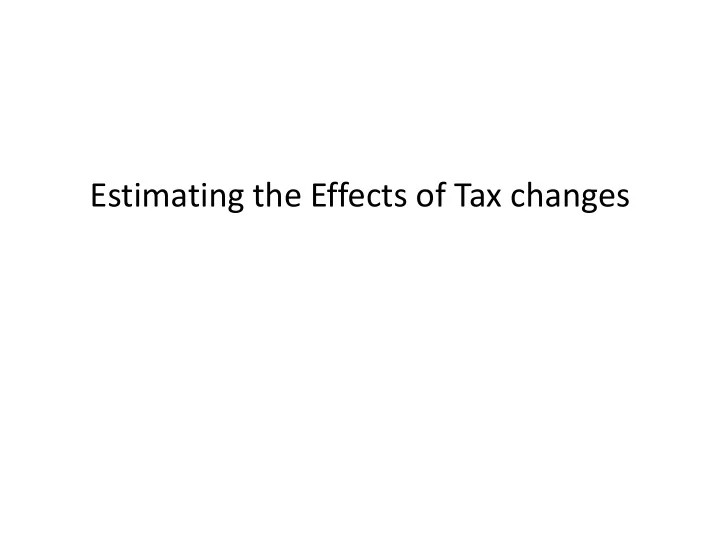

Estimating the Effects of Tax changes
Two Leading Methods for Identifying Tax Shocks Two Leading Methods for Identifying Tax Shocks • Blanchard and Perotti (2002): η �� � 𝑐 �� η �� � 𝑐 �� η �� � 𝜁 �� η �� � 𝑐 �� η �� � 𝑐 �� η �� � 𝜁 �� η �� � 𝑐 �� η �� � 𝑐 �� η �� � 𝜁 �� Recall that they also set 𝑐 �� = 𝑐 �� = 0 They set (1) 𝑐 �� = 𝑐 �� = 0 to identify the government spending shock; and (2) they use outside information to set 𝑐 �� =2.08.to identify the tax shock. • Romer‐Romer (2010) narrative method: Identify legislated tax changes motivated by reducing inherited deficits or by promoting long‐run growth as exogenous to current state of the economy. 2
Mertens‐Ravn’s Contributions Mertens‐Ravn’s Contributions • Split the Romer shocks into anticipated vs. unanticipated Deals directly with issue of fiscal foresight. • Reconciles Blanchard‐Perotti and Romer Methods Develop proxy SVARs to do so. • Distinguish between changes in personal income taxes and corporate income taxes 9
Effect of Unanticipated Romer Tax Shock, Trivariate VAR, 1950q1 – 2006q4 Mertens‐Ravn Proxy SVAR (90% confidence intervals) Tax Revenue Output 2.5 10 5 0 -2.5 0 -5 -5 0 5 10 15 20 0 5 10 15 20 They confirm Romer‐Romer’s large negative multipliers: around ‐2.5 to ‐3.0. BP had preset the elasticity of tax to GDP at 2.08. MR estimate it to 3.13. This makes a big difference for the estimation multiplier. 10
Econometric problems caused by fiscal foresight.
Tax news Tax news • Do agents really have foresight? http://lorenzkueng.droppages.com/ 12
Tax news Tax news • One of the best ways to deal with foresight is to try to measure the news and incorporate it. • Three main methods: • Romer‐Romer tax shocks with more than 90 days between legislation and implementation (Mertens‐ Ravn) • Spreads between federal and municipal bonds Leeper, Richter, Walker (2011), Kueng (2016) • DSGE models (Schmidt‐Grohe and Uribe (2012), Miyamoto‐Nguyen (2015) do this for other types of news) 13
Mertens‐Ravn AEJ: Econ Policy. (Left is unanticipated tax decrease, right is anticipated tax decrease implemented at quarter 0.)
Effect of Anticipated Romer Tax Increase, Mertens‐Ravn (2011) Estimates 1950q1 – 2006q4 (90% confidence intervals) Output Nondurable Consumption Hours 1 4 2 1 2 0 -3 -2 -1 0 0 -1 -2 -2 -4 -5 0 5 10 15 20 -5 0 5 10 15 20 -5 0 5 10 15 20 Investment Durable Consumption 5 10 5 0 -15-10 -5 0 -15-10 -5 -5 0 5 10 15 20 -5 0 5 10 15 20 16
Effect of News of Future Tax Increase, Leeper, Richter, Walker (2011) Measure Jorda local projection Output Hours Nondur. + Services Consumption 10 20 5 10 0 0 -30 -20 -10 0 -5 -10 -15 -10 -20 0 5 10 15 20 0 5 10 15 20 0 5 10 15 20 Durable Consumption Nonresidential Investment Residential Investment 40 20 40 60 50 20 0 0 -40 -20 0 -50 -40 -20 -100 0 5 10 15 20 0 5 10 15 20 0 5 10 15 20 17
Summary of Tax Results Summary of Tax Results • Results using Romer‐Romer tax shocks are fairly robust. There are potential issues with instrument relevance, though. • Fiscal foresight for taxes is theoretically and empirically important. • Strong, robust effects of anticipated tax changes. 18
Recommend
More recommend